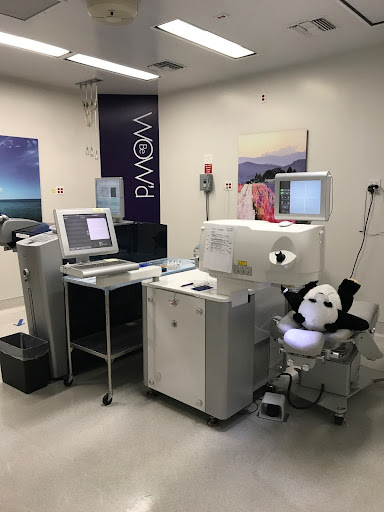Blurry distance vision, the hassle of switching between glasses and contacts, and the ongoing struggle to find a prescription that truly feels right are everyday frustrations for many people with vision problems. Over time, these challenges can lead to one important question: Is there a long-term solution that works?
One of the most well-known solutions is LASIK. However, many people don’t realize that not everyone qualifies for it, and your prescription plays a major role in that decision.
In this blog, we’ll examine why your prescription plays a key role in determining your eligibility for LASIK eye surgery. Vision correction isn’t a one-size-fits-all process. Whether you’re nearsighted, farsighted, or have astigmatism, your prescription helps determine whether this advanced procedure fits your eyes.
Let’s break down what makes a prescription suitable for LASIK.
What are the Prescription Requirements for LASIK Eligibility
LASIK is designed to reshape your cornea based on specific vision correction needs. But not every prescription qualifies. The numbers on your glasses or contact lens prescription tell more than how well you see. They show what kind of correction your cornea would need. Surgeons assess this information carefully to determine if LASIK can deliver safe and lasting results.
There are specific ranges that make someone very likely a good candidate for LASIK:
- Myopia (nearsightedness): typically between -1.00 and -8.00 diopters
- Hyperopia (farsightedness): up to +4.00 diopters
- Astigmatism: usually up to 3.00 diopters, sometimes slightly higher
- Your vision must remain stable for at least 12 months
Although these are general guidelines, they are not hard and fast boundaries; LASIK candidacy is determined on a case by case basis through thorough examination of each individual patient’s eyes. Generally speaking, however, if your prescription exceeds these ranges, LASIK might not be the safest or most effective choice. Other treatments, like PRK or implantable lenses, could be better suited for higher corrections.
Ultimately, your prescription helps guide the entire decision-making process. Understanding these eligibility requirements helps set expectations before entering a consultation room.
Why Your Prescription Matters for LASIK Candidacy
Your prescription is more than a number; it directly shapes how your LASIK procedure is planned and whether it’s viable. It helps surgeons assess how much correction is needed and how your eyes may respond to treatment.
Each type of vision problem affects LASIK candidacy differently. Here’s a closer look at what your prescription means for your eligibility:
Myopia (Nearsightedness): Ideal Ranges and Limitations
Nearsightedness is one of the most commonly treated conditions with LASIK. If you’re myopic, you see well up close but struggle with clarity at a distance. LASIK corrects this by flattening the cornea to help light properly focus on the retina.
Surgeons usually consider LASIK safe and effective for myopia within the range of about -1.00 to -8.00 diopters. While some cases beyond that can be treated, outcomes become less predictable, and the risk of side effects increases. Thinner corneas and high correction levels can limit options, so precise pre-operative measurements are essential.
Hyperopia (Farsightedness): Special Considerations
Farsightedness requires a different approach. LASIK works by steepening the cornea rather than flattening it. This correction is less stable and more sensitive to small inaccuracies, especially in higher prescriptions.
The typical upper limit for LASIK in hyperopic patients is around +4.00 diopters. Surgeons are cautious with these cases because farsighted eyes tend to have smaller treatment zones and a greater risk of regression. Long-term success relies heavily on accurate mapping and choosing the right surgical approach.
Astigmatism: When It’s Treatable and When It’s Not
Astigmatism occurs when the eye’s surface is irregular, causing blurred or distorted vision. Many people with astigmatism are good candidates for LASIK, but not every case fits the criteria. Treatment depends on the type and severity of the astigmatism and how stable the condition is.
Mild to moderate regular astigmatism is often treatable. Irregular astigmatism, especially from injury or corneal disease, is not always correctable through LASIK. A reliable LASIK surgeon will determine whether your corneal shape supports a predictable outcome or if another procedure might offer better results.
Presbyopia: Age-Related Vision Changes and LASIK Options
Presbyopia typically develops in your 40s and affects your ability to focus on near objects. It’s not caused by the shape of the cornea but by the natural aging of the eye’s lens. Since LASIK reshapes the cornea, it doesn’t reverse presbyopia directly.
However, surgeons may use techniques like monovision LASIK, where one eye is corrected for near vision and the other for distance. This can reduce your dependence on reading glasses. A trial with contact lenses is often used first to test whether or not this would be a suitable option for the patient.
How Surgeons Evaluate Your Prescription Before LASIK
Surgeons examine more than just your glasses or contact lens numbers. A full evaluation helps them understand the structure and health of your eyes, ensuring that LASIK is safe and likely to succeed.
Let’s look at the key steps in evaluating your prescription before surgery:
Comprehensive Eye Examination
Before anything else, you’ll go through a detailed eye exam. This includes measuring your exact prescription, checking your pupil size, and evaluating your eye health. Surgeons also look for signs of conditions like dry eye or glaucoma that could affect healing or outcomes.
This exam ensures that your eyes are correctable and healthy enough for surgery. It also confirms that your prescription is accurate and up to date.
Corneal Thickness Assessment and Its Relationship to Prescription
LASIK removes corneal tissue, so having enough thickness is critical. If your cornea is too thin, there’s a higher chance of complications after surgery. The amount of tissue removed depends on how strong your prescription is.
Surgeons use tools like pachymetry and topography to measure and map the cornea. This tells them whether your eyes can safely handle the amount of reshaping required for correction.
Prescription Stability Assessment
LASIK works best when your vision has remained unchanged for at least a year. If your prescription is still changing, the surgery results may not last. Surgeons verify this through previous prescription records or a waiting period if needed.
They also factor in your age, since younger patients are more likely to experience vision changes. Stability gives confidence that your results will be long-term.
Custom vs. Standard LASIK Based on Prescription Complexity
Not all LASIK treatments are the same. Some eyes require more precise adjustments than standard LASIK can offer. That’s where custom LASIK comes in, using advanced mapping technology to tailor the treatment to your unique visual profile.
If your prescription includes higher-order aberrations or is outside the average range, custom LASIK may provide better clarity and night vision. While it may increase the LASIK eye surgery cost, many patients find the improvement in results worthwhile. Surgeons will guide this choice based on what will give you the most accurate correction.
Making the Right Decision About LASIK Based on Your Prescription
Choosing LASIK isn’t about chasing perfect vision. It’s about making an informed decision based on what your prescription allows and how your eyes are built. Your diopter range, corneal thickness, and overall eye health directly influence how well LASIK will work for you and whether it’s even the right procedure in the first place.
A solid first step is verifying that your prescription meets the typical treatment ranges. But that’s not the only factor. Stability, corneal measurements, and how your eyes respond during your consultation all matter just as much. That’s why working with a surgeon who takes the time to evaluate your visual profile, not just the numbers on your chart, is critical.
If LASIK isn’t the right fit, there are alternatives worth exploring. PRK might suit your needs better. The goal is always safe, lasting vision correction, not a rushed procedure. With the right information and a trusted specialist, you’ll know if LASIK is the right call or if another path will give you better results.





